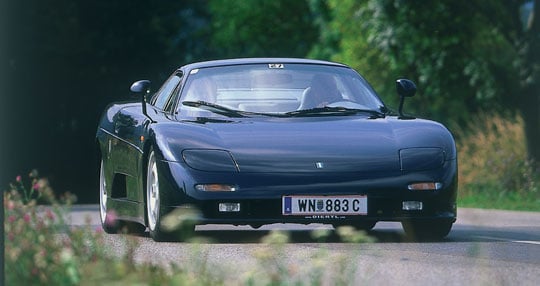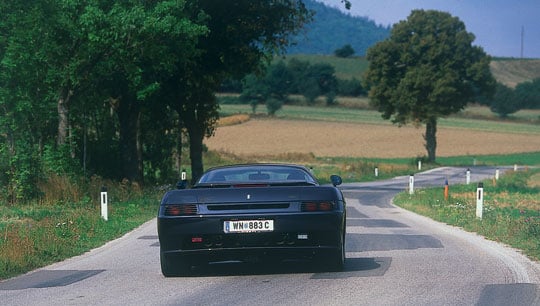
The following is an extract from Roberto Giordanelli’s feature in Auto Italia magazine, March 2005. For access to the full feature, plus articles on Christian Hrabalek's Fenomenon Stratos, driving a Maserati Quattroporte from Rome to Modena, the Lancia Fulvia 2C, Abarth 850TC and much more, see www.auto-italia.co.uk
Tumbleweed now rolls between the silent buildings of the dusty De Tomaso factory but, one day, a long way into the future, the De Tomaso label will reappear. Maybe Ford will resurrect it, maybe a far-east manufacturer, maybe someone else. In the meantime, dust must settle and people must die. The De Tomaso marque has something that the big boys want - a name, a racing heritage and a dash of exotic.
De Tomaso’s last production sportscar was the Guara. The name Guara comes from a large South American wild dog. In some ways the Guara is a link with De Tomaso’s past - a sort of DNA throwback. The Argentinean was very much racing-orientated in his early days. His 1970 F1 team was run by someone called Frank Williams. De Tomaso pursued the lightweight backbone chassis for his road car - a mid-engined glassfibre-bodied car - the Vallelunga.
The Guara may look like just another supercar but it is actually quite radical. Like an F1 car, the only luggage that you can carry in a Guara is a credit card. The chassis is a lightweight alloy backbone type, with a small lightweight frame at each end upon which to mount the suspension. The tub is in lightweight composite material and the motor is mid/rear-mounted. Add the longest suspension arms of any road car, inboard coil-overs and huge brakes, and you have a serious piece of kit.
The featured Guara is the property of De Tomaso collectors Franz and Gerda Krump and is as new as you will ever find, having covered just 3300km. The new price for the Guara was 145,000 euros (£100k ) and the current value of an average car is about 70,000 euros (£48k). The Krumps live near Vienna and bought the Guara a year ago when it had just 1173km on the clock. Chassis number 0007 was first registered in Germany in October 1996. In total, about 50 Guaras were built, spanning 12 difficult years from 1992 until 2004. Ten of these cars were Barchettas and four were Spiders. Styling is by Carlo Gaino, who unsurprisingly also penned the Maserati Barchetta. The clean lines of the Guara with its wide Marchesini wheels (8.5x18 and 10.5x18) tucked away and its forward sitting position are certainly distinctive.
Two engine options were available: a BMW 4.0-litre 304bhp V8 and a Ford 4.6-litre 330bhp V8. The Krump’s car has the BMW motor but don’t panic. It may have less power than the Ford but its lighter overall weight (1200kg as opposed to 1400kg) means a better power-to-weight ratio: 253bhp per tonne (for BMW) compared with 236bhp per tonne (for Ford). This in turn means not only quicker acceleration but better braking and sharper handling. De Tomaso switched to the Ford motor as it cost one third the price of the BMW engine.

Town or country the Guara takes centre stage - everyone notices it. Heads turn and people talk. On empty Austrian roads the Guara has a chance to stretch its legs. Sitting position is excellent and the faster you let it go, the more you understand this wild dog. In time-honoured supercar style, the controls lighten up with speed. Roll is minimal but any mid-corner lift-off swings the Guara’s tail about. Typical of this layout, fast cornering relies on technique: light braking on turn-in to transfer weight and settle the front end, balanced throttle mid-turn and more throttle on exit. The Guara’s superb traction will not unsettle the rear unless conditions are slippery.
The feeling you are left with is one of fulfilment; fulfilment in having tamed the beast. It’s not an easy car to drive but a rewarding one. Noise apart, you are always aware that you are piloting something special. That sense never leaves you all the time you are behind the wheel. The old ‘racing car on the road’ cliché is ridiculous but the Guara does have track-day capability. Power, handling and braking are up for a track attack. We all know that racing cars are as useless on the road as road cars are on the track, but the Guara doesn’t care.
This wild designer dog lurks somewhere between the two.
|
Words by Roberto Giordanelli and pictures courtesy of Phil Ward and Auto Italia magazine.
See www.auto-italia.co.uk or call 01858 438817 for back issues and subscriptions. |
ClassicInside - The Classic Driver Newsletter
Free Subscription!



